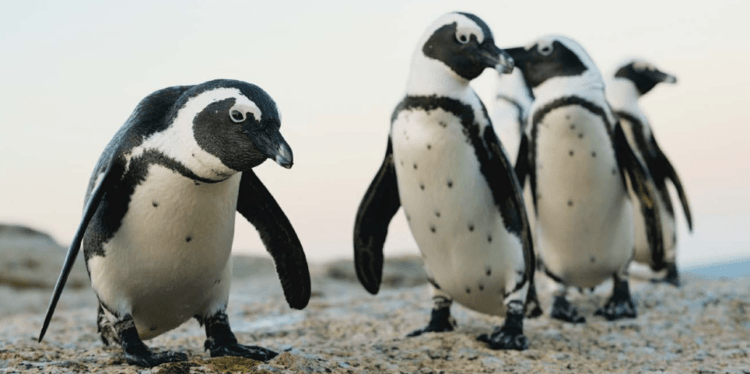We wound our way downward through the scrubby vegetation. With the cries of gulls overhead, we followed the boardwalk toward the beckoning sound of the surf. A glance at the immense Granite boulders protecting the beach from the unpredictable South Atlantic revealed the aptly named coastline. Boulders Beach in Simonstown, South Africa is a stunning spot. Sheltered inlets of crystal water fade to turquoise, marking the transition to the deeper waters off the Cape Peninsula beyond. Forming part of the Table Mountain National Park Marine Protected Area, the beach is a division of South African National Parks (SANParks) and a national treasure. Though it is a place of unsurpassed natural beauty, we were there for the most famous residents of the beach.
The African Penguin, Spheniscus demersus (meaning wedge-shaped plunger) is a creature of seeming contradiction. An exclusively African species representing a family of 18 living species of birds, most of which are found in Antarctic waters, these little guys stand out among their cold-water cousins. They also stand out for their larger-than-life vocalizations. Described as sounding like a braying donkey, the mating calls seem like they could not possibly emanate from the small, elegant seabirds.
Sporting trademark black and white plumage like their cousins, these birds reach lengths of 24-27 inches and attain weights of 4.5 to 11 pounds. Like related species, their feathers are predominantly white on the under side and blackish on the back, with a bold white “ram’s horn” sweep of feathers extending over the bird’s eyes, wrapping the sides of its head, and extending down its flanks. With a black chest and flank patch and peppering of black flecks, each bird has similar, yet distinctive individual patterning which provides both protection from predators and identification recognition among members of the colony. Utilizing a form of camouflage known as countershading, the penguin blends in with shades of deep water when seen from above and blends in with diffuse skylight, when seen from below. A sharply pointed beak, black webbed feet and slim tapered wings round out the appearance of these handsome birds.
The combination of hot coastal temperatures and cold ocean waters make for simultaneously challenging environmental extremes. So how do the birds cope with this temperature swing? While the bird’s dense waterproof plumage keeps it warm against the cold South African waters, a unique bare patch of skin above the penguin’s eyes enables it to dissipate excess body heat when the mercury soars. The hotter the bird gets, the more blood flows to these exposed patches of skin. There, the blood is cooled by the surrounding air to lower the bird’s internal temperature. Due to increased blood flow, the bare patches gain a deeper shade of pink as the bird warms up.
To fuel bodies capable of handling such temperature demands—which must also attain 15 miles per hour (nearly three times the speed of an Olympic swimmer) to avoid Great White sharks and capture speedy fish such as Capelin and Night Smelt, these birds must consume high quantities of protein-rich prey daily. Hunters of small fish and crustaceans, these hardy little penguins can hold their breath for over 2 minutes and can dive to depths of 400 feet where they forage for sardines, anchovies, crustaceans, and squid. Stoking up on such prey, African Penguins can eat more than one pound of food (14% of their bodyweight) daily!
Yet as well-adapted as these birds are to their environment, they face human- induced challenges. With a naturally restricted range from Namibia to South Africa, their limited habitat is under pressure from coastal development and fisheries over-harvesting. With worldwide population estimates of several million birds in the early 20th century, the penguins h ave suffered a plummeting decline with an estimated 42,000 birds surviving to day. Originally detected as a single pair emerging from the surf of Bouders Beach in 1982, the African Penguin colony has grown to an estimated 3,000 birds which represents a critical subpopulation!
Recognizing their significance as a key component to a healthy ocean ecosystem, as well as our ability to aid in their recovery, conservation organizations such as Connecticut’s Beardsley Zoo, The San Diego Zoo Wildlife Alliance, and the Southern African Foundation for the Conservation of Coastal Birds (SANCCOB) have worked to protect these endangered seabirds. As a seabird conservation specialist organization, SANCCOB’s mission centers on strengthening populations of seabirds affected by oil spills and low fish availability.
Additionally, the scientists and response teams of SANCCOB help to rescue, rehabilitate, and release penguins that have been oiled, abandoned, or injured.
In the African Penguin we have a creature which is superbly adapted to f unction as a key species in the ocean ecosystem yet an animal which needs our help. Though facing many threats to its survival, it is a resilient bird which responds to conservation efforts and rallies support through its appeal. And when you’re black and white, and cute all over—that’s some appeal.
Jim Knox serves as the Curator of Education for Connecticut’s Beardsley Zoo. A Member of The Explorers Club, Jim enjoys sharing his passion for wildlife and conservation with audiences in Connecticut and beyond.





